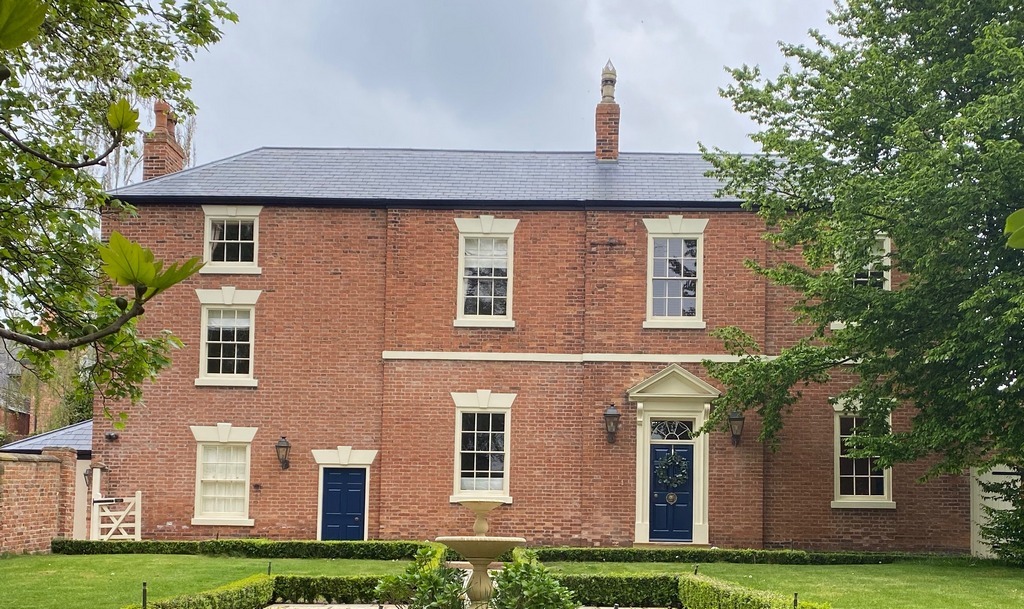Farnsfield Heritage Trail
Introduction
Farnsfield was recorded as ‘Franesfeld’ and ‘Farnesfeld’ in the Domesday book in 1086, meaning a fern-clad clearing in the woods. The village has changed over time from a scattered group of farmsteads on the edge of Sherwood Forest to the thriving principal commuter village it is today, embracing 21st century living.
The trail highlights some of the major heritage buildings and places of interest within the conservation area. The associated trades and occupations such as the saddler and harness maker, butchers, blacksmiths, bakers and inn keepers, have made Farnsfield a popular and self-sufficient place to live over time.
There is even a lock-up for inhabitants who embraced life too fully!
The Farnsfield Village Heritage Trail has been created by Farnsfield Local History Society and is based on research into the buildings and their stories. It links to, and expands on, the Historic Farnsfield display boards at the bottom of The Ridgeway and Cockett Lane. Find out more about the buildings, businesses and people who lived here over the centuries from our website: https://farnsfieldlhs.co.uk.
Mobile phone user friendly map [ Here ]
Hover on the location button for details

Heritage Trail Locations

1 The Grange
Built in the early 19th century, The Grange is an excellent example of the style of house being built by wealthy farmers at the time. Built from local stone, on a stone plinth, the Doric columns were added some 50 years after the main building. From around 1910 until 1952, The Grange was home to one of Farnsfield’s most enterprising businessmen, Alexander Straw, who was a grocer, baker and corn miller and was regularly seen making deliveries in the village in his horse-drawn cart.

2 The Plough
The Plough has been serving ale for over 250 years. Much of the original external fabric and many of the old beams can still be seen. In 1831 it had its own brewhouse, stabling for 16 horses, a well-stocked dovecote, a cowhouse, calf-house and piggery. When the village church was rebuilt in 1860 several old pews found a new home here.
A short distance further along on the south side of the road you will see Old Manor Farm. In the 1890s and early 1900s Pogson’s Carriage Works employed wheelwrights and carpenters to make and mend carts in the yard next to the farmhouse.

2. The Old Wheatsheaf
The Old Wheatsheaf was built as a farmhouse between 1625 and 1650 and it later became a Public House. It was very much the centre of village activity, used for village meetings and coroners’ inquests as well as a place to meet for a drink. As you walk up towards Atherleys bakery you will see evidence of other aspects of village life. Can you see the chain on the side wall of Scissors hairdressers? This was part of a pulley used to haul meat carcasses into what was a butcher’s shop run by Mr William Robinson.

4. Farnsfield Bakery (formerly Atherleys Bakery)
Just before Farnsfield Bakery (Atherleys) is The Pot Yard. This is the site of an earthenware business where pots and roof tiles were made for much of the 19th century. Atherleys bakery first opened in 1936 and changed ownership in 2023, which made it the longest running family business in the village. The house behind the bakery shop is reputed to be the oldest domestic building in the village, possibly dating from the early 17th century and containing medieval timbers. It probably originated as a farm with a plot of land or ‘croft’ running down to Beck Lane. It was converted to domestic use following the Enclosure Act of 1777.

5 Burgess House
Burgess House is a fine Georgian two-storey brick house with attached cottage to the left. In the late 18th century, until her death in 1823, it was the home of Sarah Thornally (later Burgess when she married in 1802). It is likely that Sarah was mistress to John Watson of Farnsfield Hall, a very wealthy landowner and that he was father of her illegitimate son John Thornally Watson. When he died in 1789, John Watson left her a great deal of money which would have enabled her to acquire the property. In 1950s and 1960s Jack Denman ran his theatrical casting agency from his home at Burgess House. One of his clients was the actor Pat Phoenix, who played Elsie Tanner in Coronation Street. She visited Farnsfield in 1970 to open the Cricket Club Carnival.

6 St Michael & All Angels Church
There has been a church on this site since the 15th century. All that remains from that period is part of the tower and the old font, no longer in use. In 1859 the Nottingham Architects Hine and Evans were commissioned to design a fine new church which was completed in 1860. Through the 19th Century the chime of the church clock assisted George Yates, Farnsfield’s blind postman, in his job. Each day when the clock struck 8.00, George would set off to Southwell to collect the mail. In 1857, to celebrate 21 years of his eventual 33-year service, the bell-ringers rang out ‘several merry peals’ on the church bells in his honour.

7 The Lion Inn & The Green
The first recorded licensee, at the former Red Lion Inn, was William Heather in 1746. During the October Feast the cattle, sheep and pig fair would take place in the croft attached to the inn, along with stalls and a pleasure fair. Little of the original building is now visible.
The village maypole was erected on The Green from 1850. Saddler’s Cottage at the bottom of Blidworth Road, was a collar and harness maker’s workshop for many years. The large shop window is still a feature, as is the ring on the outside wall for tying up the horse. At the road junction with Chapel Lane as you walk down Mansfield Road, you will see the site of another horse-related business, at Blacksmith’s Cottage.

8 The Village Lock-up
Built in July 1850, the lock-up is one of the last, and perhaps plainest, of its kind in the country. It was used to detain people accused of criminal acts or drunk and disorderly behaviour until they could be taken before the Magistrate in Southwell. The heavy door with handmade nails and barred window are still capable of holding in miscreants!
In October 1850 the local newspaper reported that Mr and Mrs Wilson were lodged in the lock-up for being drunk and disorderly. The next morning about 100 people gathered to witness their release. Walk back along Mansfield Road towards the church. There are many early 19th century cottages in this area. Many have been rendered because the local Farnsfield brick was soft and porous. Turn left at Rose Cottage onto New Hill.

9 The Village Centre
The Village Centre, on the left as you walk up the hill, probably dates from the early 1800s when it was built as a Maltings or Malt House. Several maltsters lived on New Hill including Ann and John Knutton (1840s – 1860s) and John Wright, the last maltster to work in the building in the early 20th century.
The building was bought for the village in 1949 by Sir Stuart Goodwin, a Sheffield steel magnate and philanthropist, who lived at Hexgreave Hall. It was converted into a youth centre and village hall. Turn right at the crossroads onto Chapel Lane

10. The Wesleyan Methodist Chapel.
Farnsfield’s first Methodist chapel opened in 1799 on Siding Lane (now Station Lane), but it became inadequate for the growing congregation. The present chapel, funded by subscription, opened on Tuesday 28th April 1829. The land it stands on was a gift from Richard Hall, a wealthy farmer, whose wife Sarah Hall was a niece of Sarah Burgess and had inherited Burgess House in 1823. The Wesleyan Day School at the rear of the Chapel opened in 1840 and closed in 1969 when Walter d’Ayncourt Primary School was built.
Acknowledgments: We are grateful to Janine Buckley, Miner2Major Heritage Buildings Project Lead, for guidance during the development of the trail. Production of this guidebook was funded by The Farnsfield Trust. Printing was funded by Miner2Major, supported by the National Lottery Heritage Fund. Design work by Chris Matthews & Magda Kapciak.
Contributors Logo’s

Scan the QR code to your phone or to share with a friend
Opens the Heritage Trail on the Website




